Yes, SSDs have become so popular nowadays, they are not as expensive and expensive as they used to be.
Now, with only 500k, you can own yourself an SSD hard drive already. Although it is not as good as the series SSD names like Intel, Kington, KingMax .. but in general, its speed is also much faster than traditional HDD.
I remember that only 2 years ago I bought a 128GB SSD hard drive for computers, to be an operating system. At that time, it was 1 million 550 thousand, but now I see the price is more than 600k. It is true that technology is growing so fast: V
Okay, back to the main point in this article. Because SSDs have become more common, users are using them more and more. Therefore, in this article I will introduce you how to optimize the hard drive with SSD software FRESH. This is a small piece of software but optimally supports the hard drive extremely well.
If you do not want to use the software to optimize, you can also rely on this article to do it manually. Only if you use this software, you will reduce the operations, it can be said that with just one click, your hard drive has been properly optimized.
Read more:
#first. Introduction to SSD software FRESH
SSD FRESH Developed by Abelssoft, this is an extremely compact software, it optimally supports SSDs extremely effectively and with just 1 click.
Even if you do not have any knowledge of the computer, you can optimize your SSD easily.
#2. Key features of the FRESH SSD software
- Optimize SSDs when using Windows operating system by turning off unnecessary features.
- Reduce the number of read / write times for SSDs to increase the life of SSDs.
- Increase the performance of SSDs by disabling unnecessary services on Windows.
Okay, details about how come in later in the tutorial I will explain more specifically for you.
# 3. Download the latest SSD FRESD software
// Note: This is a paid software, so if you want to use the Full feature, please buy the license of this software from their homepage. Or if you do not have economic conditions, you can search on Google with keywords download software SSD FRESD full is the whole basket 😛
# 4. Install the FRESD SSD software
After downloading, install it on your computer. The installation process is very easy, so I do not guide this step.
Double click on the downloaded file => then go ahead Next => Next that's it!
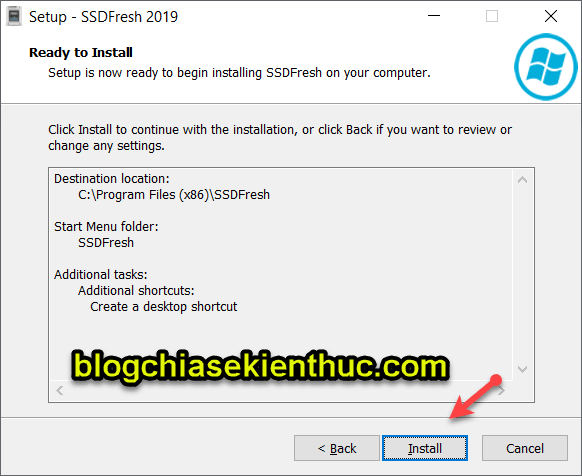
Press Finish to finish the installation process.
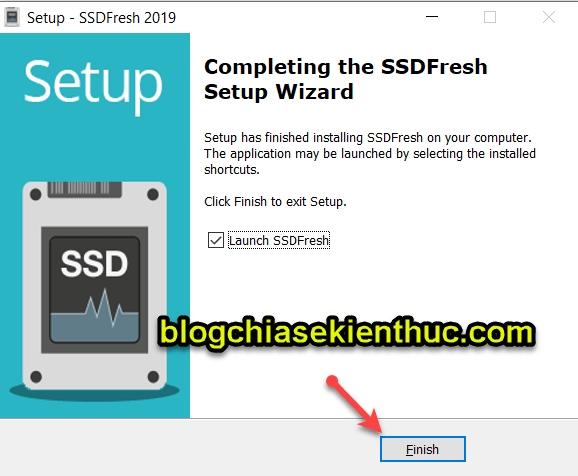
# 5. Guide to use SSD FRESD to optimize SSD hard drive
This is the main interface of the software SSD FRESD. We will have 3 main tabs that are:
- Overview:Here, you can view the list of drives, view the information of hard drive partitions ...
- Optimization: Here will provide options to optimize your SSD hard drive.
- Live-Analysis: Track analytics directly.
And here you will have 2 options:
- OPTIMIZE AUTOMATICALLY: Optimize your SSD automatically.
- OPTIMIZE MANUALLY: Optimize SSD settings manually.
Now I will access the option OPTIMIZE MANUALLY Let's see if there's anything.
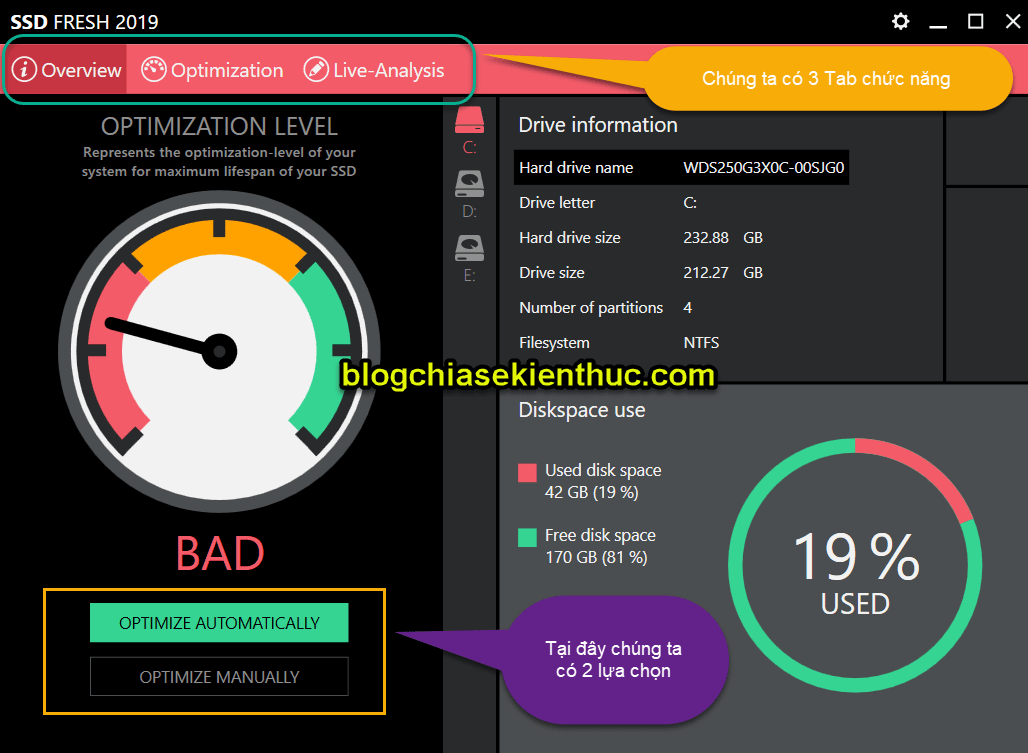
There, here will appear a lot of suggestions to help you optimize your SSD hard drive. Based on this, you can set it up manually without this software 😀
But first, pay attention to the 2 buttons Create Backup to perform a backup of the configuration before optimization. If later, you are not satisfied with the optimization, you can click the button Restore Backup to revert to the previous state.
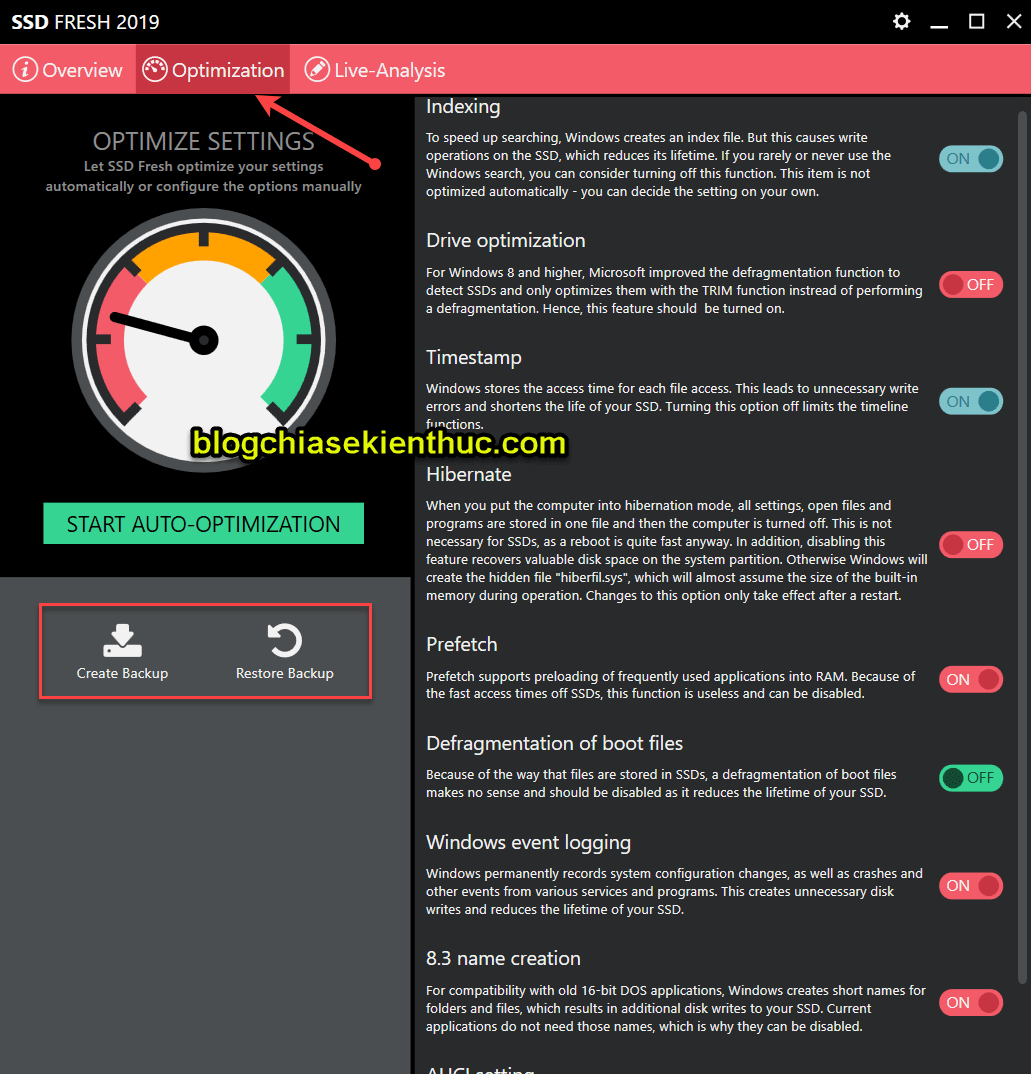
Okay, now we will go into more detail on each suggestion that the program gives:
1 / Indexing: To speed up searching, Windows creates an index file. But this causes write operations on the SSD, which reduces its lifetime. If you rarely or never use the Windows search, you can consider turning off this function. This item is not optimized automatically - you can decide the setting on your own.
// Translation:
Indexing: To speed up the search, the Windows operating system has created an index file. But this will cause write operations on the SSD, reducing its lifespan. If you rarely or never use the search feature on Windows, you might consider disabling this function. This item is not automatically optimized - you can decide to install it yourself.
=> Tips: Switch to OFF.
2 / Drive optimization: For Windows 8 and higher, Microsoft improved the defragmentation function to detect SSDs and only optimizes them with the TRIM function instread of performing a defragmentation. Hence, this feature should be turned on.
// Translation:
Optimize the drive: For Windows 8 and above, Microsoft has improved the defrag function to detect SSDs and only optimize them with the TRIM function. Therefore, this feature should be enabled.
=> Tips: Switch to ON.
3 / Timestamp: Windows stores the access time for each file access. This leads to unnecessary write errors and shortens the life of your SSD. Turning this option off limits the timeline functions.
// Translation:
Timestamp: Windows will store access time for each time you access any file. This will lead to unnecessary writing errors, and shorten the life of the SSD. Disable this option to limit timeline functions.
=> Tips: Switch to OFF.
4 / Hibernate: When you put the computer into hibernation mode, all settings, open files and programs are stored in one file and then the computer is turned off. This is not necessary for SSDs, as a reboot is quite fast anyway. In addition, disabling this feature recovers valuable disk space on the system partition. Otherwise Windows will create the hidden file "hiberfil.sys", which will almostither the size of the built-in memory during operation. Changes to this option only take effect after a restart.
// Translation:
Hibernate: When you leave the computer in hibernation mode, all settings and open programs on the computer will be stored in a file. This is not necessary for SSDs, because restarting the computer is pretty fast anyway. In addition, when you disable this feature, you will have more storage space for the hard drive. If you do not disable this feature, Windows will create a hidden file called "hiberfil.sys", which will take on the size of the integrated memory during operation. This option change only takes effect after you restart the computer.
=> Tips: Switch to OFF.
5 / Prefetch: Prefetch supports preloading of frequently used applications into RAM. Because of the fast access times off SSDs, this function is useless and can be disabled.
// Translation:
Prefetch: Prefetch supports preloading commonly used applications into RAM. Because the access time to an SSD is very fast, this function is useless and can be disabled.
=> Tips: Switch to OFF.
6 / Defragmentation of boot files: Because of the way that files are stored in SSDs, a defragmentation of boot files makes no sense and should be disabled as it reduces the lifetime of your SSD.
// Translation:
Defragmenting startup files: Because of the way files are stored in SSDs, defragmenting boot files is useless, and should be disabled because it reduces the life of the SSD.
=> Tips: Switch to OFF.
7 / Windows event logging: Windows permanently records system configuration changes, as well as crashes and other events from various services and programs. This creates unnecessary disk writes and reduces the lifetime of your SSD.
// Translation:
Event diary: Windows records system configuration changes, as well as incidents and other events from different services and programs ... This creates unnecessary disk burning and it will shorten the life of the SSD. yours.
=> Tips: Switch to OFF.
8 / 8.3 name creation: For compatibility with old 16-bit DOS applications, Windows creates short names for folders and files, which results in additional disk writes to your SSD. Current applications do not need those names, which is why they can be disabled.
// Translation:
8.3 name creation: For compatibility with older 16-bit DOS applications, Windows creates short names for folders and files, resulting in additional disk writing to your SSD drive. Current applications do not need those names, which is why they can be disabled.
=> Tips: Switch to OFF.
9 / AHCI setting: Warning: This setting serves as an advice for possible optimization potential for experts only. Changes are not provided at this point. AHCI is an standard interface for SATA hard disks. SSD hard disks should be connected using AHCI to achieve full, performance.
// Translation:
Install AHCI: Warning: This setting acts as advice for optimization potentials that may be reserved for professionals only. Changes are not provided at this time. AHCI is an interface standard for SATA hard disks. SSDs should be connected using AHCI to achieve full performance.
=> This section if you are not familiar with the computer should not touch, and usually we have to access the BIOS to set up.
After finishing soaking, you press the button START AUTO-OPYIMIZATION to perform optimally automatically.
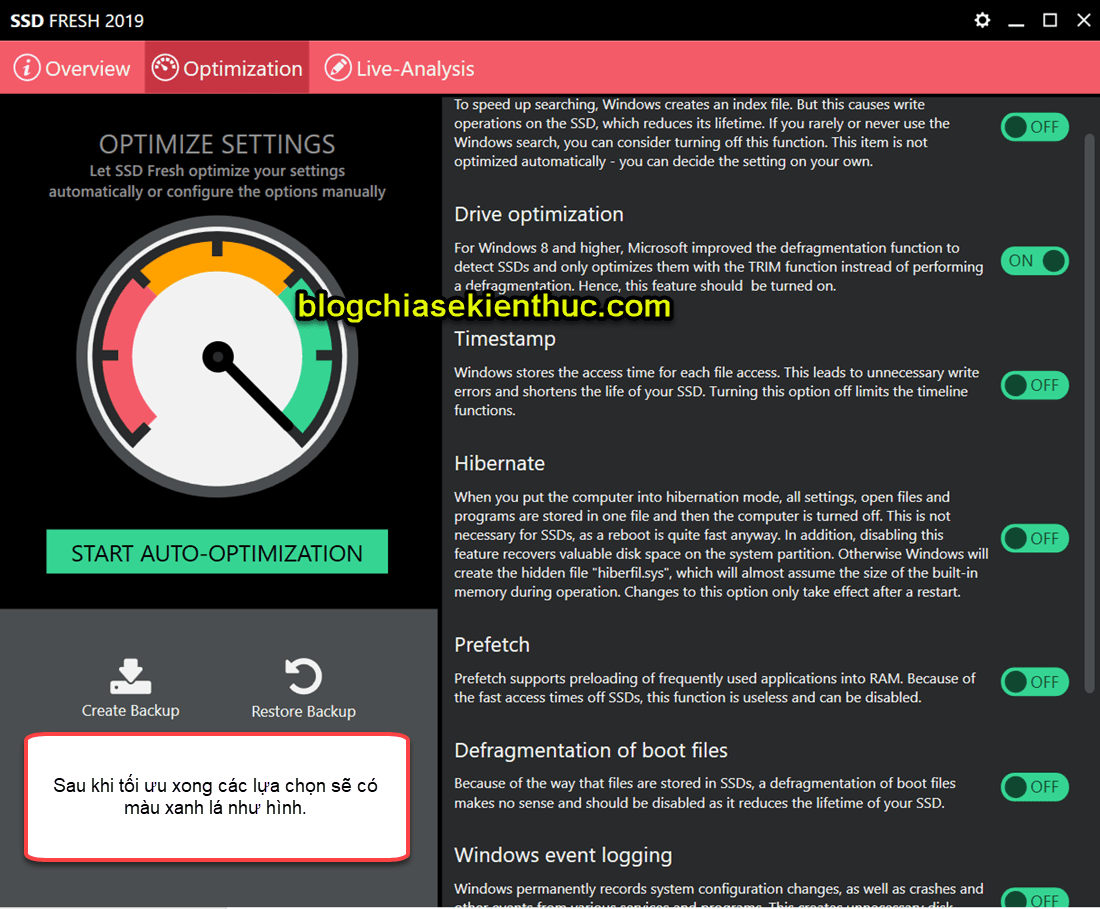
After optimization, it is as blue as the picture above 😀
If you want to restore the previous state is not optimal then you press the button Restore Backup is to be. But of course, before that you have to press the button Create Backup Alright then 😛
Alternatively, you can switch to tabs Live-analysis => click the button START to view real time analysis.
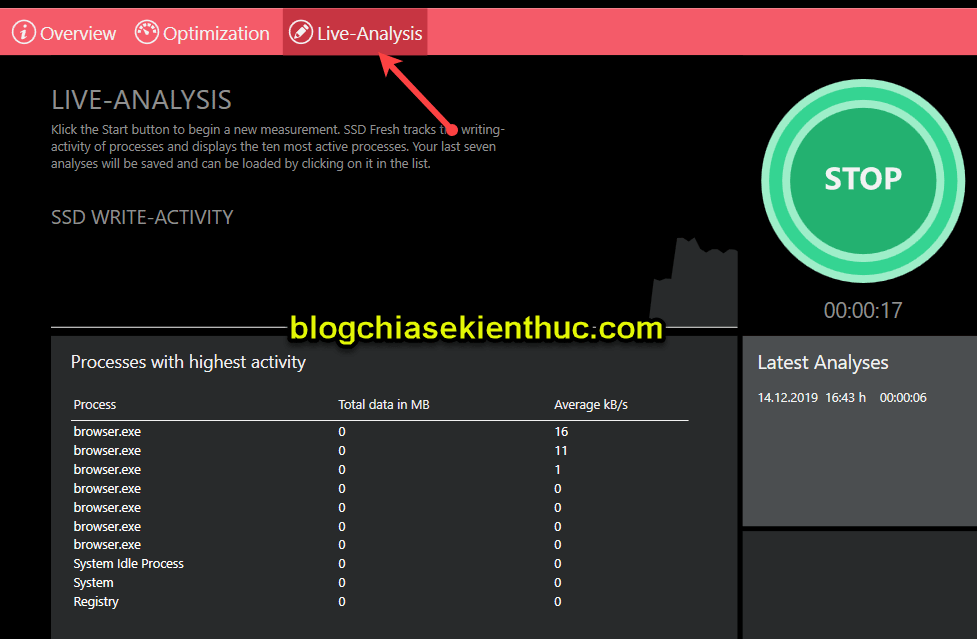
# 5. SSD optimization tool of each vendor
Well, maybe you do not know that some manufacturers of large SSD drives, they provide tools to monitor and optimize SSDs completely free.
Note: Below each tool I will put 2 links, the first link is a direct link from the company's homepage, you should download this link to get the latest version. In case you cannot download due to an error or you do not know how to download, use the backup link on the side.
5.1. Download Samsung's SSD hard drive optimization tool called Samsung Magician
5.2. Download the SanDisk SSD optimization tool called SanDisk SSD Dashboard
5.3. Download the SanDisk SSD optimization tool called Transcend SDD Scope
5.4. Download the Corsair SSD optimization tool called Corsair SSD Toolbox
5.5 Download Intel SSD hard drive optimization tool named Intel SSD Toolbox
5.6 Download the Crucial SSD optimization tool called Crucial Storage Executive
Download here or here ! Only for 64-bit operating systems you guys.
5.7 Download Kingston's SSD hard disk optimization tool called SSD Manager
# 6. Epilogue
So I have detailed instructions for you how to optimize SSD hard drive with 1 mouse click Alright then. In fact, the Windows 10 operating system is also quite good optimization, we just need to add a few more such operations is OK.
In short, how to reduce the number of read / write of the hard drive will help increase the life of the SSD. That's all !
Hope this article will be helpful to you, wish you success!
Kien Nguyen - Blogchiasekienthuc.com
Note: Was this article helpful to you? Do not forget to rate the article, like and share it with your friends and relatives!


0 Comments